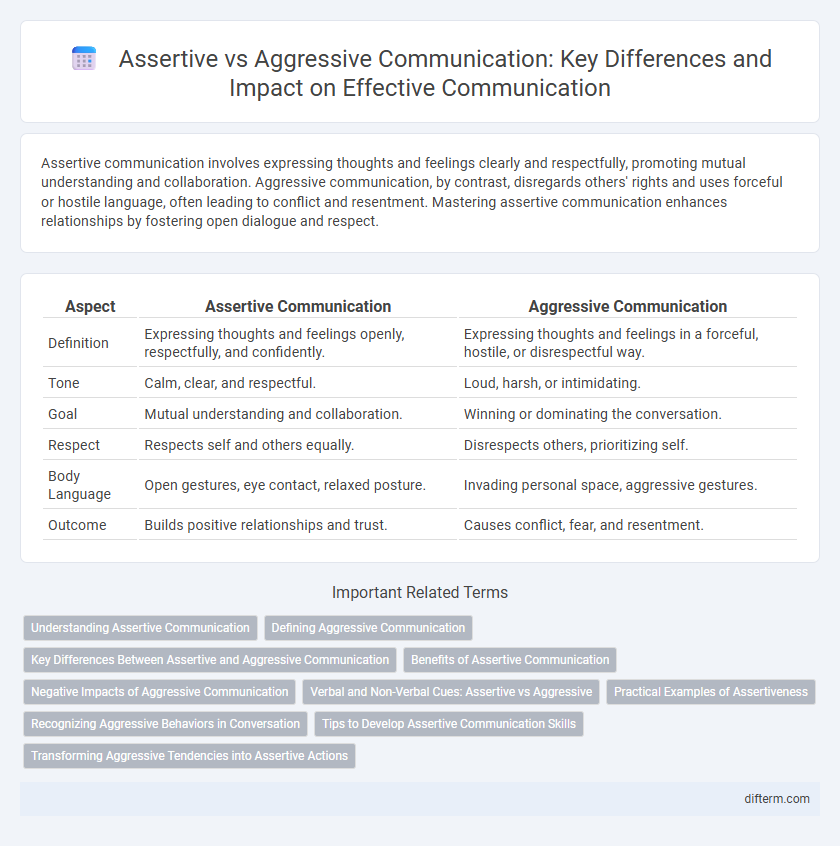Assertive communication involves expressing thoughts and feelings clearly and respectfully, promoting mutual understanding and collaboration. Aggressive communication, by contrast, disregards others' rights and uses forceful or hostile language, often leading to conflict and resentment. Mastering assertive communication enhances relationships by fostering open dialogue and respect.
Table of Comparison
| Aspect | Assertive Communication | Aggressive Communication |
|---|---|---|
| Definition | Expressing thoughts and feelings openly, respectfully, and confidently. | Expressing thoughts and feelings in a forceful, hostile, or disrespectful way. |
| Tone | Calm, clear, and respectful. | Loud, harsh, or intimidating. |
| Goal | Mutual understanding and collaboration. | Winning or dominating the conversation. |
| Respect | Respects self and others equally. | Disrespects others, prioritizing self. |
| Body Language | Open gestures, eye contact, relaxed posture. | Invading personal space, aggressive gestures. |
| Outcome | Builds positive relationships and trust. | Causes conflict, fear, and resentment. |
Understanding Assertive Communication
Assertive communication involves expressing thoughts and feelings clearly and respectfully while maintaining boundaries and considering others' perspectives. It promotes open dialogue, reduces misunderstandings, and fosters mutual respect without hostility or passivity. Understanding assertive communication enhances interpersonal relationships by encouraging honesty, confidence, and effective problem-solving.
Defining Aggressive Communication
Aggressive communication involves expressing thoughts and feelings in a forceful, often hostile manner that infringes on others' rights and disregards their feelings. It typically includes behaviors like interrupting, yelling, and blaming, which can lead to conflict and damaged relationships. This style contrasts with assertive communication, which seeks clarity and respect through honest, direct, and considerate expression.
Key Differences Between Assertive and Aggressive Communication
Assertive communication respects both personal rights and the opinions of others, using clear, calm, and direct language to express feelings and needs without causing harm. Aggressive communication involves dominating or intimidating others through loud, hostile, or disrespectful speech that violates others' rights. Key differences include tone, intention, and the impact on relationships, where assertiveness fosters mutual respect and aggression damages trust and rapport.
Benefits of Assertive Communication
Assertive communication promotes clear and respectful expression of thoughts and feelings, fostering mutual understanding and stronger relationships. It enhances conflict resolution by encouraging open dialogue without hostility, reducing misunderstandings and tension. This communication style boosts self-confidence and emotional intelligence, contributing to personal and professional growth.
Negative Impacts of Aggressive Communication
Aggressive communication often leads to misunderstandings, damaged relationships, and increased conflict in both personal and professional settings. This style creates a hostile environment, undermining trust and cooperation among team members. Persistent aggression can result in decreased morale, heightened stress levels, and reduced productivity.
Verbal and Non-Verbal Cues: Assertive vs Aggressive
Assertive communication uses clear, confident verbal cues with a balanced tone and steady pace, paired with open body language, such as direct eye contact and relaxed posture, indicating respect and self-assurance. Aggressive communication often features loud, abrupt statements, interruptions, and a commanding tone, while non-verbal cues include clenched fists, glaring eyes, and an invading personal space, signaling hostility and dominance. Understanding these distinctions in verbal and non-verbal cues enhances effective interpersonal interactions and conflict resolution.
Practical Examples of Assertiveness
Assertive communication involves expressing thoughts and feelings clearly and respectfully, such as calmly stating personal needs without infringing on others' rights. For example, saying "I need more time to complete this project" demonstrates assertiveness by setting boundaries while maintaining professionalism. In contrast, aggressive communication might involve demanding completion with threats or insults, which undermines constructive dialogue and collaboration.
Recognizing Aggressive Behaviors in Conversation
Recognizing aggressive behaviors in conversation involves identifying signs such as interrupting others, raising one's voice, and using accusatory language. These behaviors often undermine constructive dialogue and create defensive responses, disrupting effective communication. Awareness of these patterns helps individuals shift towards assertive communication, fostering respect and clarity in interactions.
Tips to Develop Assertive Communication Skills
Develop assertive communication skills by practicing clear and direct language that respects both your rights and others' feelings. Use "I" statements to express your thoughts and needs without blaming or judging, which helps prevent misunderstandings and conflicts. Maintain calm body language and eye contact to reinforce confidence and sincerity in your message.
Transforming Aggressive Tendencies into Assertive Actions
Transforming aggressive tendencies into assertive actions involves recognizing emotional triggers and adopting clear, respectful language that expresses needs without violating others' rights. Techniques such as active listening, using "I" statements, and maintaining steady body language help shift confrontational behavior into constructive dialogue. Developing assertive communication enhances relationship dynamics by promoting mutual understanding and reducing conflict.
assertive communication vs aggressive communication Infographic

 difterm.com
difterm.com